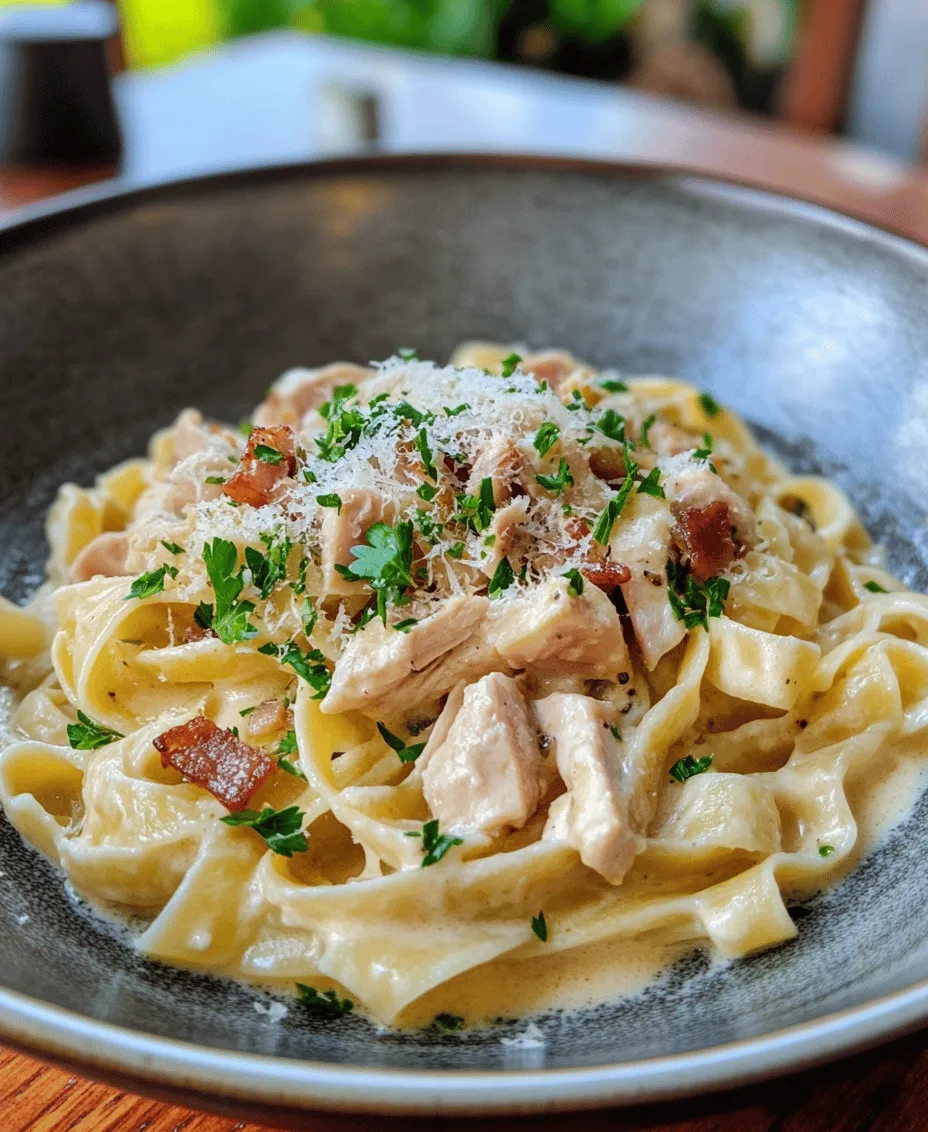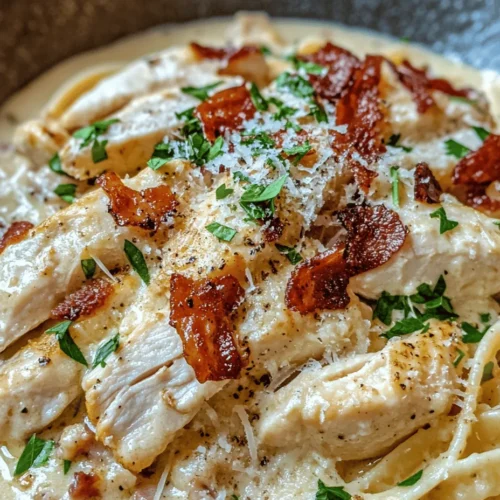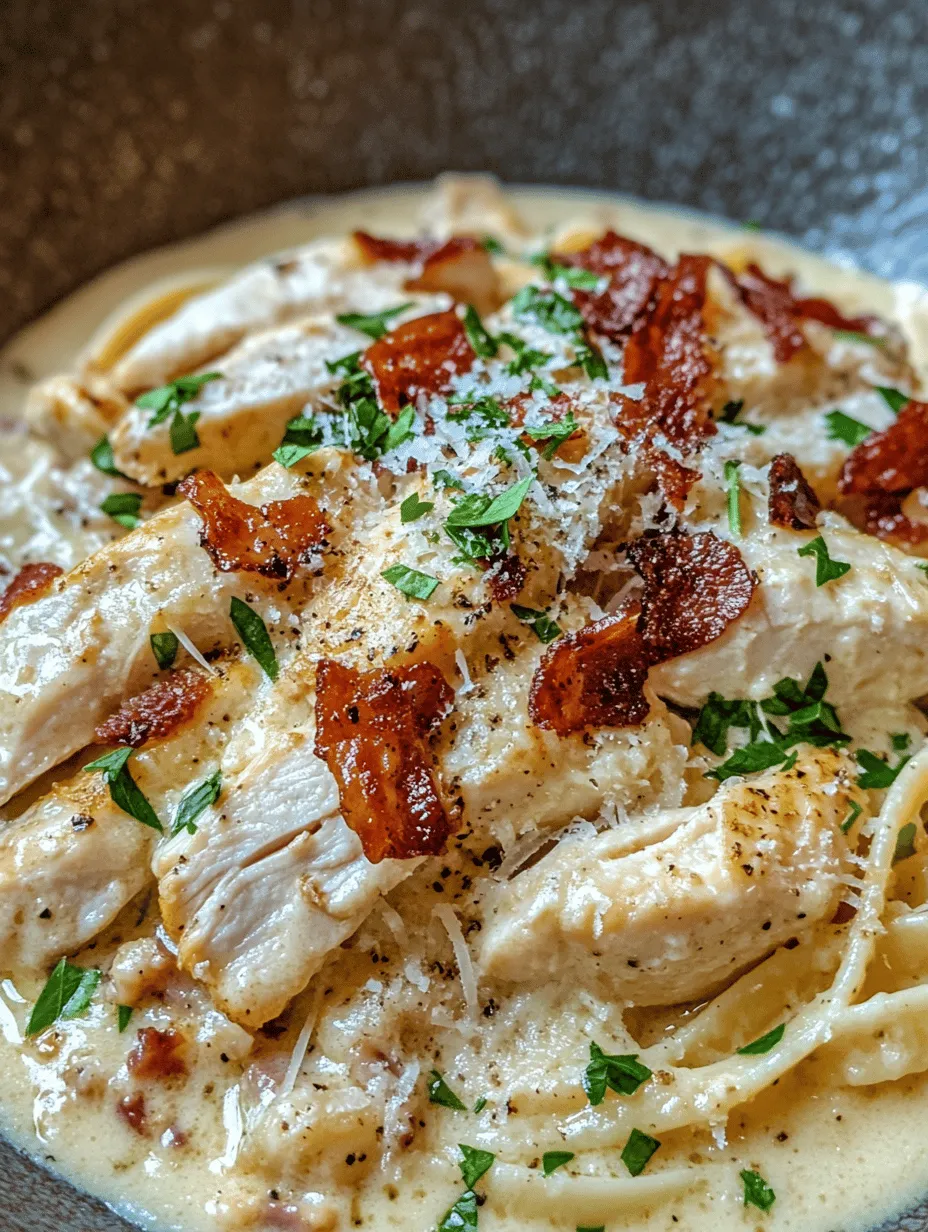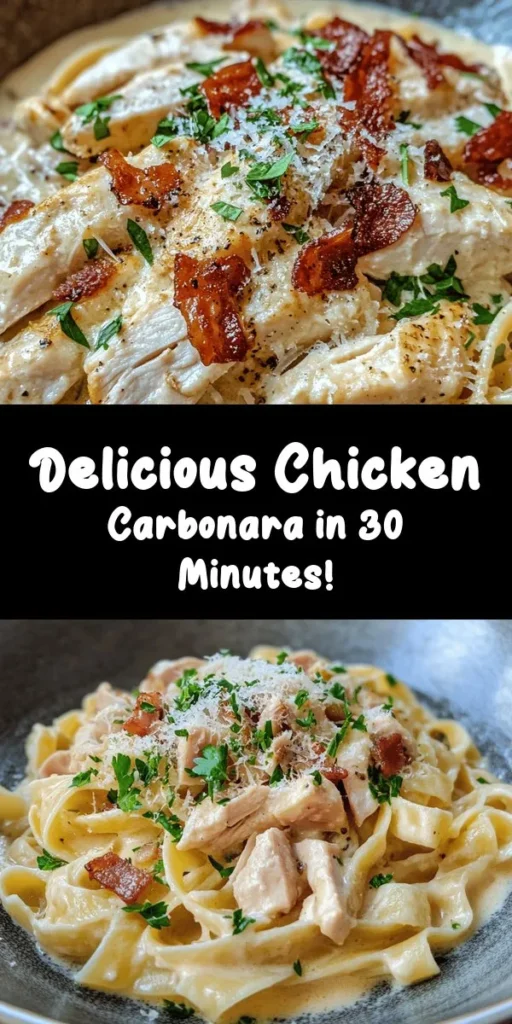Introduction
When it comes to Italian cuisine, few dishes are as beloved and comforting as Chicken Carbonara. Originally hailing from the Lazio region, this dish has transcended borders to become a staple on tables around the world. What makes Chicken Carbonara so irresistible? It’s the perfect harmony of rich flavors, creamy textures, and the satisfying combination of tender chicken and crispy pancetta. As you dive into this recipe, you’ll discover that the secret to a truly spectacular Chicken Carbonara lies in using fresh, high-quality ingredients that elevate the dish from ordinary to extraordinary.
This recipe is designed to be approachable, allowing you to whip up a restaurant-quality meal in the comfort of your own kitchen. Whether you’re cooking for a busy weeknight dinner or preparing a special meal for loved ones, this Chicken Carbonara promises to impress. The balance of flavors—creamy sauce, savory chicken, and the salty crunch of pancetta—creates a dish that is both indulgent and comforting. Let’s explore the origins of Carbonara, break down the essential ingredients, and guide you through the initial steps of crafting this Italian classic.
Understanding the Origins of Carbonara
The history of Carbonara is as rich as the dish itself. While its exact origins are somewhat shrouded in mystery, it is widely believed to have been created in the mid-20th century in Rome. The most popular theory suggests that the dish was a favorite among coal miners, known as “carbonai” in Italian, hence the name Carbonara. Traditionally, Carbonara is made with just a few key ingredients: pasta, eggs, cheese, cured pork, and black pepper.
In its traditional form, Carbonara does not contain cream; instead, the creaminess comes from the emulsification of the egg yolks and cheese with the starchy pasta water. However, modern interpretations have seen the addition of cream to create an even richer sauce, leading to variations that may stray from the authentic recipe. Regardless of the method used, the essence of Carbonara remains the same: simple, yet flavorful ingredients that come together to create a comforting dish.
Using authentic Italian ingredients is paramount when preparing Chicken Carbonara. High-quality pasta, fresh eggs, and genuine Pecorino Romano or Parmesan cheese all contribute to the dish’s signature taste. While it’s tempting to modify recipes to fit personal preferences, staying true to traditional components will ensure an authentic Italian experience on your plate.
Ingredients Breakdown: What Makes This Chicken Carbonara Special
The best Chicken Carbonara starts with the right ingredients. Each component plays a crucial role in creating the dish’s signature flavor profile. Here’s a closer look at what makes this Chicken Carbonara truly special:
Spaghetti vs. Fettuccine: Which to Choose?
While traditional Carbonara is typically made with spaghetti, you may wonder if fettuccine could be a suitable alternative. Both types of pasta have their merits: spaghetti’s long, thin strands allow the sauce to coat each piece evenly, while fettuccine’s wider noodles provide a heartier bite. Ultimately, the choice between spaghetti and fettuccine comes down to personal preference. If you enjoy a classic approach, stick with spaghetti; if you want something a bit more substantial, opt for fettuccine.
The Role of Olive Oil in Creating a Rich Flavor
Extra virgin olive oil is a staple in Italian cooking, and its inclusion in Chicken Carbonara is no exception. Not only does olive oil add a depth of flavor, but it also helps to sauté the pancetta and chicken to golden perfection. When selecting olive oil, choose a high-quality extra virgin variety for the best results. Its fruity notes will enhance the overall richness of the dish.
Importance of Boneless, Skinless Chicken Breasts for Tenderness
For this Chicken Carbonara, boneless, skinless chicken breasts are the ideal choice. They are tender, quick to cook, and absorb flavors beautifully. When prepared correctly, they yield juicy pieces that complement the creamy sauce perfectly. To ensure even cooking, consider cutting the chicken into uniform pieces before sautéing.
The Difference Between Pancetta and Bacon
Pancetta and bacon may seem similar, but they have distinct differences that impact the flavor of Chicken Carbonara. Pancetta is an Italian cured meat made from pork belly, seasoned with spices, and aged for a few months. It has a rich, savory flavor that enhances the dish without overpowering it. On the other hand, bacon is typically smoked and has a stronger flavor profile. While you could substitute bacon in a pinch, using authentic pancetta will yield a more traditional and balanced taste.
Why Fresh Eggs and Parmesan Cheese are Essential for the Sauce
The creamy sauce of Chicken Carbonara relies heavily on fresh eggs and quality cheese. The eggs provide a luscious creaminess when emulsified with the pasta water, while freshly grated Parmesan cheese adds a nutty depth. When selecting cheese, opt for finely grated Parmesan or Pecorino Romano for the best results. These cheeses melt beautifully and will create a velvety sauce that clings to the pasta.
The Impact of Garlic and Black Pepper on the Overall Taste
Garlic and black pepper are essential components that elevate the flavor of Chicken Carbonara. Garlic adds a subtle aromatic quality, while freshly cracked black pepper provides a necessary kick that balances the richness of the sauce. Be sure to use freshly ground black pepper for the best flavor, as pre-ground varieties can lose their potency over time.
Optional Ingredients for Customization
While this Chicken Carbonara recipe provides a classic approach, there is room for customization. For those who enjoy a bit of heat, consider adding red pepper flakes to the pancetta while it cooks. You might also include peas for a pop of color and sweetness, or fresh herbs like parsley for a burst of freshness. Feel free to experiment and make the dish your own while keeping the core flavors intact.
Step-by-Step Instructions to Perfect Chicken Carbonara
Now that you have a better understanding of the ingredients that make this Chicken Carbonara special, it’s time to dive into the cooking process. Follow these step-by-step instructions to achieve a creamy, flavorful dish that is sure to impress.
Cooking the Pasta: Techniques for Achieving the Perfect Al Dente Texture
1. Boil Water: Start by bringing a large pot of salted water to a rolling boil. The salt will help season the pasta as it cooks, enhancing the overall flavor of the dish.
2. Add the Pasta: Once the water is boiling, add your choice of spaghetti or fettuccine. Stir gently to prevent the noodles from sticking together.
3. Cooking Time: Follow the package instructions for cooking time, but aim to cook the pasta until it is al dente—firm to the bite. This is crucial as the pasta will continue to cook slightly when combined with the sauce.
4. Reserve Pasta Water: Before draining the pasta, reserve about a cup of the starchy cooking water. This will be essential for creating the creamy sauce later.
5. Drain and Set Aside: Drain the pasta, but do not rinse it. Rinsing removes the starch that helps the sauce adhere to the noodles. Set the drained pasta aside while you prepare the chicken.
Preparing the Chicken: Tips for Seasoning and Cooking Chicken to Golden Perfection
1. Season the Chicken: While the pasta is cooking, season the boneless, skinless chicken breasts with salt and freshly cracked black pepper. This will enhance the flavor and ensure a delicious result.
2. Heat the Olive Oil: In a large skillet, heat a couple of tablespoons of extra virgin olive oil over medium-high heat. Once the oil is hot and shimmering, it’s ready for the chicken.
3. Cook the Chicken: Add the seasoned chicken breasts to the skillet, cooking for about 5-6 minutes on each side, or until golden brown and cooked through. The internal temperature should reach 165°F (75°C).
4. Let it Rest: Once cooked, remove the chicken from the skillet and let it rest for a few minutes before slicing it into bite-sized pieces. This resting period allows the juices to redistribute, ensuring tender chicken.
5. Cook the Pancetta: In the same skillet, add diced pancetta and cook over medium heat until crispy. The rendered fat from the pancetta will add flavor to the dish.
With the pasta cooked and the chicken prepared, you are now ready to combine these elements and create a delicious Chicken Carbonara that will delight your taste buds. Stay tuned for the next part of this recipe, where we’ll focus on combining the ingredients and finishing the dish to perfection.

Cooking Pancetta: Achieving the Perfect Crispiness and Flavor Infusion
The first step in mastering Chicken Carbonara is ensuring the pancetta is cooked to perfection. Start by selecting high-quality pancetta, which is essential for an authentic flavor profile. Here’s how to achieve that ideal crispiness:
1. Slice Thinly: Cut the pancetta into small cubes or strips, usually about 1/4-inch thick. This thickness allows the fat to render out properly while maintaining enough structure to add texture to your dish.
2. Use a Cold Pan: Place the pancetta in a cold, non-stick skillet, which helps to slowly render the fat without burning it. Turn the heat to medium-low. This gradual heating allows the pancetta to crisp up evenly and infuse the oil with its rich flavor.
3. Cook Slowly: Stir the pancetta occasionally to ensure even cooking. Keep an eye on it; you want it to be golden brown and crispy, which usually takes about 8-10 minutes. If you cook it too quickly over high heat, it may burn, resulting in a bitter taste.
4. Drain Excess Fat: Once crispy, use a slotted spoon to transfer the pancetta to a paper towel-lined plate, allowing excess grease to drain away. Reserve a tablespoon or two of the rendered fat in the pan; this will serve as a base for the sauce and add depth to your dish.
Combining Ingredients: Best Practices for Mixing Pasta and Proteins Effectively
Now that your pancetta is perfectly cooked, it’s time to combine the ingredients. Properly mixing pasta and protein is crucial for achieving the best flavor and texture in your Chicken Carbonara. Here’s how to do it right:
1. Timing is Key: Cook your pasta in a large pot of salted boiling water. Make sure to set a timer to avoid overcooking. The pasta should be al dente, as it will continue to cook slightly when combined with the hot sauce.
2. Reserve Pasta Water: Before draining the pasta, remember to reserve about a cup of the starchy pasta water. This water is crucial for adjusting the consistency of your sauce later on.
3. Mixing the Ingredients: Once the pasta is drained, add it directly to the skillet with the pancetta and the reserved fat over low heat. Toss the pasta gently to coat it in the flavorful oil and to combine it with the pancetta.
4. Incorporate the Chicken: If you’re using cooked chicken in your Carbonara, add it at this stage. Gently fold the chicken into the pasta, ensuring it is evenly distributed and warmed through.
Making the Sauce: Achieving a Creamy Consistency
The key to a perfect Chicken Carbonara is a creamy sauce that clings to the pasta without being overly heavy. Here’s a detailed explanation of how to achieve this through the emulsification process:
1. Whisking the Eggs: In a mixing bowl, whisk together the eggs and grated Pecorino Romano cheese until fully combined. The heat from the pasta and pancetta will cook the eggs gently, transforming them into a luscious sauce.
2. Emulsification Technique: Remove the skillet from the heat to prevent the eggs from scrambling. Add a splash of the reserved pasta water to the egg mixture, whisking vigorously. This technique gradually incorporates the heat, allowing the mixture to thicken without cooking too quickly.
3. Combine Quickly: Pour the egg and cheese mixture over the hot pasta and pancetta. Toss vigorously, adding more reserved pasta water a little at a time until you achieve a creamy, smooth consistency. The goal is to create a sauce that clings to each strand of pasta.
4. Seasoning: Taste the dish and adjust the seasoning with freshly cracked black pepper and, if needed, a pinch of salt. The pancetta and cheese already add significant flavor, so be cautious not to oversalt.
Serving Suggestions: Presentation Ideas to Enhance the Dining Experience
Presentation can elevate your Chicken Carbonara from a simple weeknight meal to a delightful dining experience. Here are some tips:
1. Plate with Care: Use large, shallow pasta bowls for serving. Twirl the pasta into a nest shape in the center of the bowl for an appealing presentation.
2. Garnish: Top each serving with additional grated Pecorino Romano cheese and a generous crack of black pepper. Fresh chopped parsley or basil can add a pop of color and freshness to the dish.
3. Add a Side: Consider serving the Carbonara with a simple side salad dressed with a light vinaigrette or garlic bread for a complete meal. This contrast in textures and flavors will enhance the overall dining experience.
Nutritional Information
Understanding the nutritional value of your meal is essential, especially when cooking for family and friends. Here’s a breakdown of the nutritional content per serving of Chicken Carbonara:
– Calories: Approximately 600-700 calories
– Protein: 30-35 grams
– Total Fat: 25-30 grams
– Carbohydrates: 70-80 grams
Tips for Making the Dish Healthier Without Compromising on Taste
1. Whole Wheat Pasta: Swap out regular pasta for whole wheat or legume-based pasta to boost fiber content and nutrients.
2. Lean Chicken: Use skinless chicken breast instead of thigh for lower fat content, while still keeping the protein high.
3. Reduce Cheese: You can cut back on the amount of cheese used or opt for a lower-fat alternative without sacrificing too much flavor.
4. Add Vegetables: Incorporate steamed broccoli or peas for added nutrition and color, making the dish even more appealing.
Common Mistakes to Avoid When Making Carbonara
Making Chicken Carbonara seems simple, but a few common pitfalls can lead to disappointing results. Here are mistakes to avoid:
1. Overcooking the Pasta: Overcooked pasta becomes mushy and may not hold the sauce well. Always aim for al dente to maintain texture.
2. Cooking the Eggs Too Long: If the eggs are exposed to direct heat for too long, they may scramble instead of creating a smooth sauce. Remove the pan from heat before adding the egg mixture.
3. Skipping Reserved Pasta Water: The starchy pasta water is essential for achieving the right sauce consistency. Never skip this step, as it helps bind the sauce to the pasta.
4. Misjudging Seasoning: Be careful with salt, especially since the pancetta and cheese are salty. Always taste before adding more salt.
Variations of Chicken Carbonara
While the classic Chicken Carbonara is delightful on its own, there are many variations to explore:
1. Vegetarian Options: Replace the chicken and pancetta with sautéed mushrooms or seasonal vegetables like zucchini and bell peppers for a delicious vegetarian option.
2. Gluten-Free Alternatives: Use gluten-free pasta made from rice or quinoa to cater to gluten sensitivities while still enjoying a creamy Carbonara.
3. Creative Twists: Enhance your Carbonara by adding sun-dried tomatoes, peas, or fresh spinach for extra flavor and nutrition.
4. International Variations: Explore different cultural takes on Carbonara, such as adding Asian-inspired ingredients like soy sauce or sesame oil for a unique flavor profile.
Conclusion
This Chicken Carbonara stands out as the best-ever version due to its carefully crafted flavors, creamy texture, and the perfect balance of ingredients. Cooking this dish at home is not just about the meal; it’s about the joy of creating a classic Italian experience in your kitchen. By following the outlined steps and tips, you can make a memorable dish that will impress family and friends alike.
Sharing food is an experience that brings people together, and making Chicken Carbonara is a wonderful way to create lasting memories around the dinner table. So gather your loved ones, roll up your sleeves, and enjoy the culinary journey of preparing this delicious meal. Your taste buds will thank you, and so will those you share it with!



